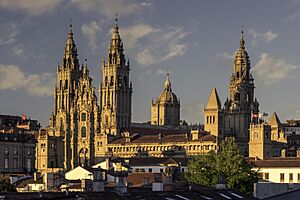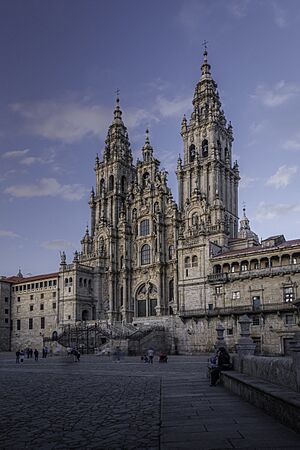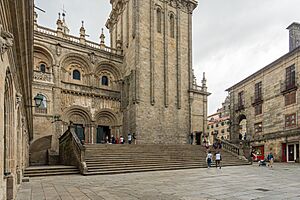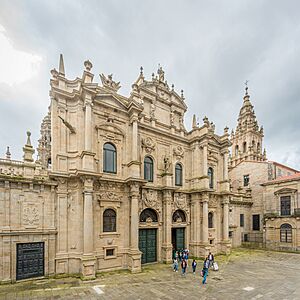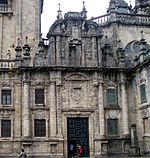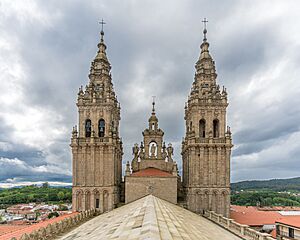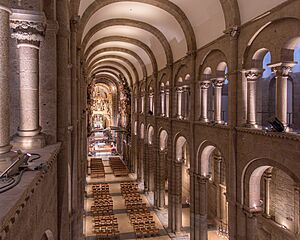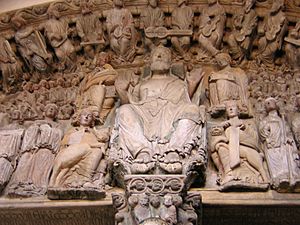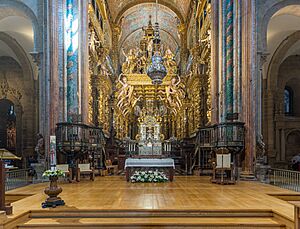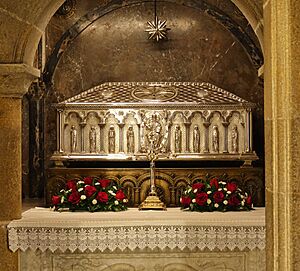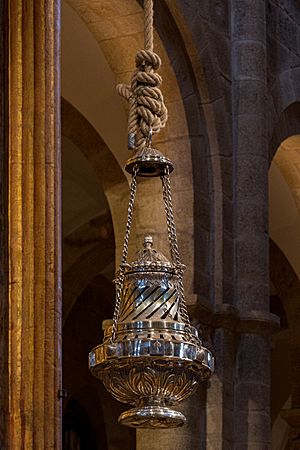Santiago de Compostela Cathedral facts for kids
Quick facts for kids Metropolitan Archcathedral Basilica of Santiago de Compostela |
|
|---|---|
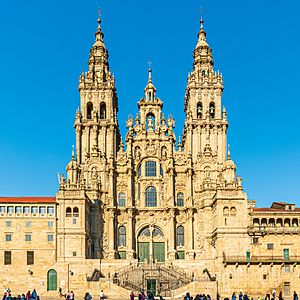
The western façade of the Metropolitan Archcathedral Basilica as seen from the Praza do Obradoiro
|
|
| Religion | |
| Affiliation | Catholic |
| District | Santiago de Compostela |
| Rite | Roman Rite |
| Leadership | Archbishop Francisco José Prieto Fernández |
| Location | |
| Location | Santiago de Compostela, Galicia, Spain |
| Architecture | |
| Architectural type | Metropolitan Archcathedral-Basilica |
| Architectural style | Romanesque, Gothic, Baroque |
| Groundbreaking | 1075 |
| Completed | 1211 |
| Specifications | |
| Direction of façade | West |
| Capacity | 1,200 |
| Length | 100 m (330 ft) |
| Width | 70 m (230 ft) |
| Height (max) | 75 m (246 ft) |
| Spire(s) | 2 |
| Official name: Santiago de Compostela (Old Town) | |
| Criteria | i, ii, vi |
| Designated | 1985 |
| Reference no. | 320bis |
| Official name: Catedral Igrexa Catedral Metropolitana | |
| 22 August 1896 | |
| (R.I.) - 51 - 0000072 - 00000 | |
The Santiago de Compostela Archcathedral Basilica is a very important church in Santiago de Compostela, Galicia, Spain. It is famous because it is believed to be the burial place of Saint James the Great. He was one of the apostles of Jesus Christ. This cathedral is one of the few churches in the world built over an apostle's tomb.
For hundreds of years, the cathedral has been a major destination for pilgrims. They walk the famous Way of St James route, which ends here. The building started as a Romanesque church. Later, parts were added in Gothic and Baroque styles.
Contents
History of the Cathedral
According to an old story, Saint James the Great brought Christianity to Spain. However, the Bible says James was killed in Jerusalem.
The Discovery of Saint James's Tomb
Legend says that in the year 814 AD, a hermit named Pelagius saw strange lights in the night sky. These lights were above a forest. Bishop Theodomirus of Iria believed this was a miracle. He told King Alfonso II of Asturias and Galicia about it. The king then ordered a small chapel to be built on the spot. It is said that King Alfonso II was the very first pilgrim to visit this holy place.
Later, a church was built in 829 AD. Then, in 899 AD, a larger church was ordered by King Alfonso III. This led to Santiago de Compostela becoming a very important place for pilgrims.
Building the Current Cathedral
In 997, the early church was destroyed by Al-Mansur, an army commander. But Saint James's tomb and relics were not harmed. The building of the current cathedral began in 1075. This was during the time of King Alfonso VI. It was built mostly from granite.
Construction stopped several times. The last main stone was laid in 1122. However, the cathedral was not fully finished then. It was officially dedicated in 1211. The city became a bishop's seat in 1075. Because it was so important for pilgrims, it became an archbishop's seat in 1120.
Outside the Cathedral
The cathedral has several impressive outer walls, called façades. Each one faces a large public square. These façades show different building styles from over the centuries.
Obradoiro Façade: The Main Entrance
The Obradoiro square in front of this façade gets its name from the workshops (obradoiro in Galician) of the stonemasons. They worked here when the cathedral was being built. This grand Baroque façade was finished in 1740. It was built to protect the older, beautiful Portico of Glory from bad weather.
In the middle of the façade, you can see a statue of Saint James. Below him are his two disciples, Athanasius and Theodore, all dressed as pilgrims. There is also an urn, which represents the rediscovered tomb, and a star, like the lights Pelagius saw. The towers on either side show statues of Saint James's parents.
A special diamond-shaped staircase, built in the 17th century, leads to the façade. It surrounds the entrance to an old 12th-century Romanesque crypt.
Pratarías Façade: The Silverware Façade
The Pratarías façade, also known as the "Silverware" façade, is on the south side of the cathedral. It is the only original Romanesque façade that remains. It was built between 1103 and 1117. Over the years, pieces from other parts of the cathedral were added to it.
This façade has two entrance doors with many sculptures. You can see figures of prophets and apostles. There are also scenes from the Bible, like Christ being tempted by demons. One famous sculpture shows King David playing an instrument. Many of these figures were moved here from other parts of the cathedral in the 18th century.
Acibecharía Façade: The Jet Stone Façade
The Acibecharía façade is on the north side. Its name comes from "jet gemstone," which was often sold nearby. The original Romanesque entrance here was destroyed by a fire in 1758. A new façade was built in the Baroque and Neoclassical styles.
At the top of this façade, there is an 18th-century statue of Saint James. Two kings are shown praying at his feet. In the center, there is a statue representing Faith.
Quintana Façade: The Royal and Holy Gates
The east façade of the cathedral faces the Quintana Square. It has two important gates: the Porta Real (Royal Gate) and the Porta Santa (Holy Gate).
The Porta Real is a Baroque gate. Kings of Spain used to enter the cathedral through this door, which is why it's called the Royal Gate. The royal coat of arms is above its entrance.
The Porta Santa, or Door of Forgiveness, is usually closed. It only opens during a Jacobean holy year. This happens when Saint James's Day (July 25) falls on a Sunday. Pilgrims can enter through this door to receive a special blessing. Inside this door, there is a small courtyard leading to the true Holy Door.
Bell Towers: Reaching for the Sky
The main façade has two tall towers. They are called the Torre das Campás (Bell Tower) and the Torre da Carraca. Both are very tall, reaching about 75 to 80 meters (246 to 262 feet) high. The first parts of these towers were built in the 12th century. They were later changed and reinforced in the 16th and 17th centuries.
Clock Tower: The Berenguela
The Clock Tower, also known as the Berenguela, is at a corner where two squares meet. It was originally built as a defense tower. Between 1676 and 1680, it was made taller and given a beautiful pyramid-shaped top with a lantern. It stands about 75 meters (246 feet) tall.
In 1833, a clock was added to each side of the tower. It has two bells. The larger one, called Berenguela, rings for the hour. A smaller bell marks the quarter hours. The original bells cracked and were replaced in 1989. During a Jacobean Holy Year, the lantern at the top of the Berenguela Tower is lit all year. This light acts like a lighthouse to guide pilgrims to the cathedral.
Inside the Cathedral
The cathedral is 97 meters (318 feet) long and 22 meters (72 feet) high. Its inside still looks mostly Romanesque. It has a main area called the nave, two side aisles, and a wide transept. Compared to many other grand churches, the inside might seem simple at first. But as you go further, you see the amazing organ and the rich decorations of the choir. It is one of the largest Romanesque churches in Europe.
Portico of Glory: A Masterpiece of Sculpture
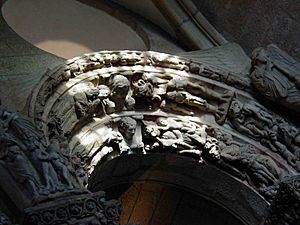
The Portico of Glory is a famous Romanesque entrance. It was created by Master Mateo and his team. It was finished in 1188. The portico has three round arches. The central arch is twice as wide as the others. It has a central column with a statue of Saint James.
The sculptures tell stories from the Bible. In the center of the main arch, you see Christ in Majesty. Around him are symbols of the four Evangelists (Matthew, Mark, Luke, and John). Angels holding instruments of Christ's Passion are also shown. The arch above has 24 elders from the Book of Revelation, playing musical instruments.
On the central column, Saint James is seated with a pilgrim's staff. Below him is the "tree of Jesse," showing Jesus's family tree. At the very bottom, facing the main altar, there is a kneeling figure of Master Mateo himself. Students and pilgrims used to gently tap their heads against this statue for wisdom.
The side arches also have many sculptures. The right arch shows the Last Judgment, with figures representing Heaven and Hell. The left arch shows scenes from the Old Testament, with figures like Adam, Eve, Moses, and King David.
The Main Altar and Choir
The main altar has a huge, richly decorated statue of Saint James from the 13th century. Pilgrims can go behind the altar through a narrow passage to kiss the saint's mantle. The chapels around the choir are like a museum. They hold many old paintings, altarpieces, and sculptures. One chapel has a gold crucifix from 874, which is said to contain a piece of the True Cross.
The Crypt: Saint James's Tomb
Below the main altar is the crypt. This is where the relics (remains) of Saint James are kept. It is also believed to hold the relics of two of his disciples, Saint Theodorus and Saint Athanasius. The silver box holding the relics was placed there in 1886.
For a long time, the exact burial place of the saint was almost forgotten. In 1589, the relics were moved to a safer place because of attacks. They were rediscovered in January 1879.
Botafumeiro: The Giant Censer
The Botafumeiro is a very famous and giant censer (a container for burning incense) in the cathedral. It is the largest censer in the world! It weighs 80 kilograms (176 pounds) and is 1.60 meters (5.2 feet) tall.
Normally, you can see it in the cathedral's library. But on important religious holidays, it is attached to a pulley system. It is filled with 40 kilograms (88 pounds) of charcoal and incense. During Jubilee Years, it is used in all Pilgrim's Masses. Eight people, called tiraboleiros, pull ropes to make it swing very high, almost to the roof. It can reach speeds of 80 kilometers per hour (50 mph), filling the cathedral with thick clouds of incense.
Other Burials
- Alfonso Daniel Rodríguez Castelao
- Fructuosus of Braga
- Rosalía de Castro
- Fernando Pérez de Traba
- Ferdinand II of León
- Alfonso IX of León
- Pedro Fernández de Castro
- Gaspar de Ávalos de la Cueva
Old images
-
Pórtico da Gloria in 1849 by Jenaro Pérez Villaamil
See also
 In Spanish: Catedral de Santiago de Compostela para niños
In Spanish: Catedral de Santiago de Compostela para niños
- Asturian architecture
- Catholic Church in Spain
- Santiago de Compostela
- 12 Treasures of Spain
- List of Christian pilgrimage sites


